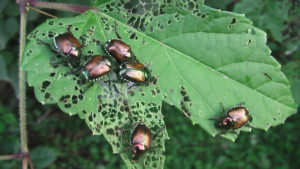Like clockwork, the bane of many gardeners has made its annual comeback.
Japanese beetles are known to devour hundreds of varieties of plants, turning leaves into skeletal “lace,” and raspberries, which are just about to ripen in Eastern Iowa, are among their favorites.
Rather than use synthetic chemicals to control the ravenous beetles, alternatives include knocking them into a bucket of soapy water — late afternoon is a prime time when the beetles are less active — and sprinkling self-rising flour on the plants you’d like to protect.
The self-rising flour is said to burst the beetles’ digestive tracts when ingested.
Chickens devour both the Japanese beetle grubs and those in the adult stage, offering another organic method of control.
More: Attack of the aphids
The beetles, easily identifiable by their copper-colored wings and metallic green head and body, consume more than 300 plants, such as linden trees, hollyhocks and grapes.
They leave behind skeletal foliage that looks like lace; another way to identify the foreign invaders, which were first recorded in Iowa in 1994.
Chemical means of attacking Japanese beetles can harm our butterflies, bees and other beneficial insects. Although they might look aesthetically less appealing, most healthy trees should survive even the voracious appetite of Japanese beetles.
Pheromone traps that lure large numbers of Japanese beetles to their deaths are said to attract more to yards and experts generally advise against their use.
The grubs of Japanese beetles burrow underground during the winter and adult beetles generally tend to disappear in Iowa around the end of July to early August.
Learn about a beneficial beetle — the lightning bug — and what it eats.


No Comments Yet